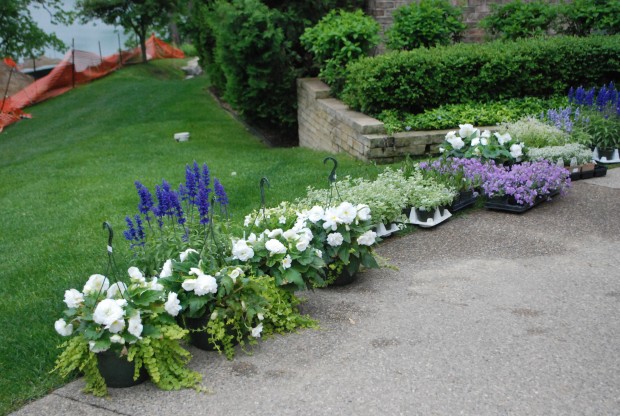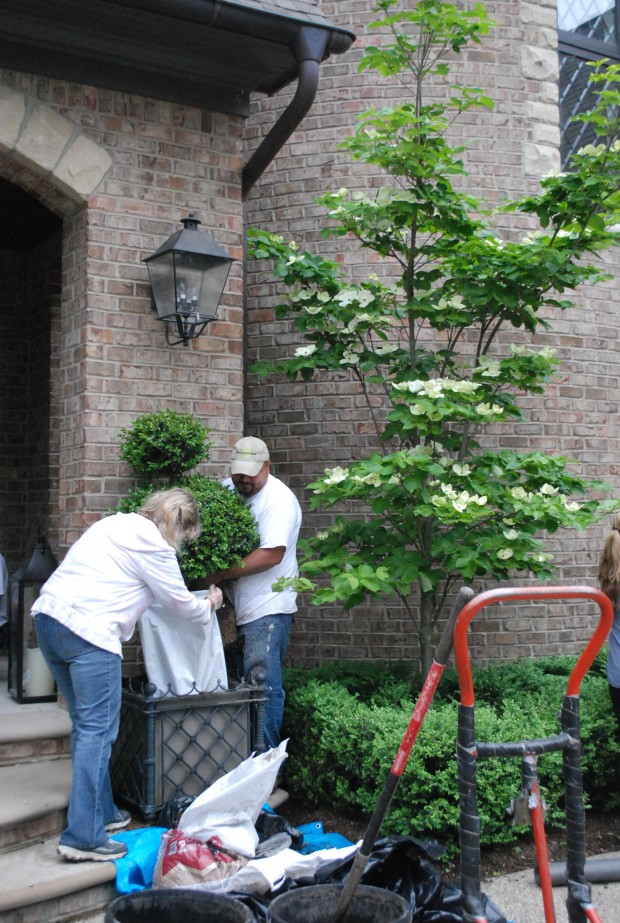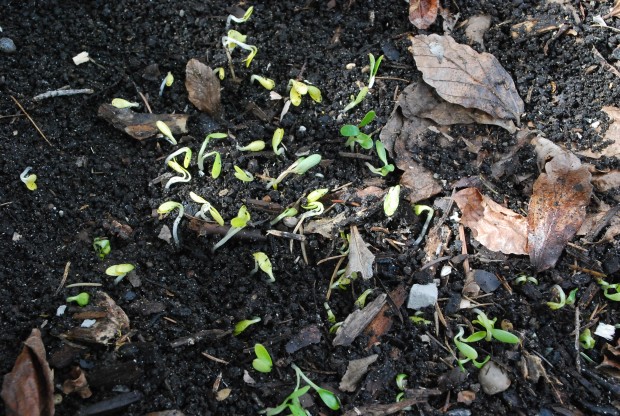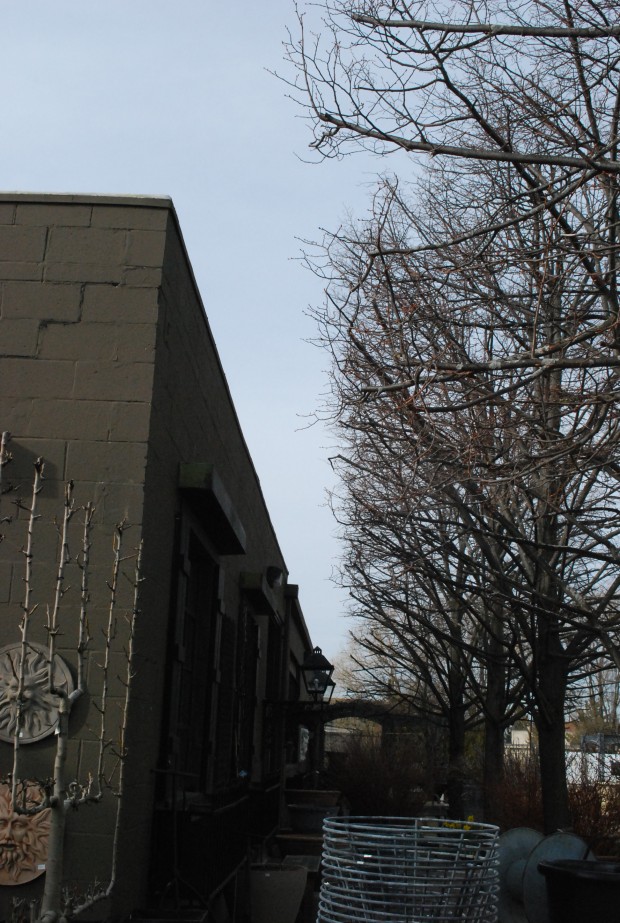 The day the evergreens get pruned at the shop is one of my favorite days in the gardening year. Mindy from M and M Flowers comes with a crew; they make a day of it. The first order of business is the discussion. Are we pruning as usual? Is there perhaps a new shape or different direction in mind?
The day the evergreens get pruned at the shop is one of my favorite days in the gardening year. Mindy from M and M Flowers comes with a crew; they make a day of it. The first order of business is the discussion. Are we pruning as usual? Is there perhaps a new shape or different direction in mind?
 Making changes to the shape of a boxwood hedge- even an established hedge- is not difficult or impossible. It just takes time. The spheres at the corners of the parterres have not grown in evenly all around. The west side spheres get more water, as the land drains in that direction. The east side spheres are planted in what was once asphalt, and they are shaded by the lindens.
Making changes to the shape of a boxwood hedge- even an established hedge- is not difficult or impossible. It just takes time. The spheres at the corners of the parterres have not grown in evenly all around. The west side spheres get more water, as the land drains in that direction. The east side spheres are planted in what was once asphalt, and they are shaded by the lindens.
 The spheres to the east also suffered a considerable fungal infection that has been very difficult to cure. Simply put, the conditions for the 4 spheres are not at all equal. One pair is much larger and more robust than the other. So there was discussion about a moving towards a different shape at all 4 corners.
The spheres to the east also suffered a considerable fungal infection that has been very difficult to cure. Simply put, the conditions for the 4 spheres are not at all equal. One pair is much larger and more robust than the other. So there was discussion about a moving towards a different shape at all 4 corners.
 The corner spheres could be trimmed as follows. The bottom of the shrub could be brought into line with the existing rectangular hedge. The top of the shrub could be pruned as a top-knot, or a smaller sphere that would appear to sit on top of the hedge. This pruning would take a few years to accomplish, as it means pruning down to old wood. There would be bare spots that would need to grow in.
The corner spheres could be trimmed as follows. The bottom of the shrub could be brought into line with the existing rectangular hedge. The top of the shrub could be pruned as a top-knot, or a smaller sphere that would appear to sit on top of the hedge. This pruning would take a few years to accomplish, as it means pruning down to old wood. There would be bare spots that would need to grow in.
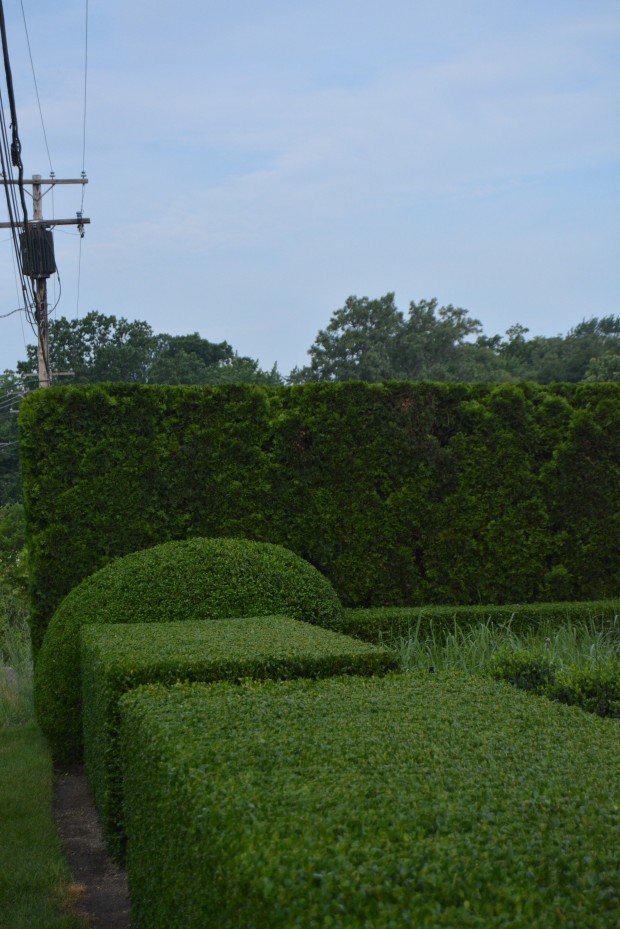 We have some time to think this over. Though I like to wait until the spring growth is fully flushed out before any pruning is done, pruning back to bare wood as the heat of the summer season is imminent is a recipe for burn. Boxwood grows out of winter burn fairly readily, but summer burn is an unsightly state of affairs that persists.
We have some time to think this over. Though I like to wait until the spring growth is fully flushed out before any pruning is done, pruning back to bare wood as the heat of the summer season is imminent is a recipe for burn. Boxwood grows out of winter burn fairly readily, but summer burn is an unsightly state of affairs that persists.
 I am not so sure that it bothers me that the spheres do not match. Perfection is a state that does not really apply to living things. We may just stay the course. But there is always the option to change course in a landscape. That just takes planning, and patience.
I am not so sure that it bothers me that the spheres do not match. Perfection is a state that does not really apply to living things. We may just stay the course. But there is always the option to change course in a landscape. That just takes planning, and patience.
 This hedge has been grown from the species buxus koreana microphylla. It is a big growing boxwood. The hedge has been maintained at a height of 32″ and a width of 48″ for a number of years. Grown in full sun, it readily handles the winter wind and cold weather. The only danger posed by the winter is when we have heavy snow, the weight of which can crack the woody branches. Those cracks make the shrub more susceptible to fungal infections. It’s not always easy to decide whether to remove the snow, or let it be. Disturbing branches when they are frozen can produce more damage than the snow itself.
This hedge has been grown from the species buxus koreana microphylla. It is a big growing boxwood. The hedge has been maintained at a height of 32″ and a width of 48″ for a number of years. Grown in full sun, it readily handles the winter wind and cold weather. The only danger posed by the winter is when we have heavy snow, the weight of which can crack the woody branches. Those cracks make the shrub more susceptible to fungal infections. It’s not always easy to decide whether to remove the snow, or let it be. Disturbing branches when they are frozen can produce more damage than the snow itself.
 Korean boxwood does have a pronounced orangy cast in the winter, a characteristic that is not to everyone’s taste. Our most important issue is tending a hedge that is in good proportion to the size of the building. If that large overall size were not so important, “Green Velvet” boxwood maintains its green color all winter, and matures at 3′ by 3′. “Green Mountain” boxwood is virtually indistinguishable from Green Velevet, but matures at 4′ tall, and 3′ wide. “Green Gem” is a good choice, if a more refined leaf and smaller mature size is what your garden needs.
Korean boxwood does have a pronounced orangy cast in the winter, a characteristic that is not to everyone’s taste. Our most important issue is tending a hedge that is in good proportion to the size of the building. If that large overall size were not so important, “Green Velvet” boxwood maintains its green color all winter, and matures at 3′ by 3′. “Green Mountain” boxwood is virtually indistinguishable from Green Velevet, but matures at 4′ tall, and 3′ wide. “Green Gem” is a good choice, if a more refined leaf and smaller mature size is what your garden needs.
 We lost 2 boxwood in the hedge over this past winter. We did have one replacement available. In this spot, we went another direction. We stitched the hedge back together, with a pair of potted boxwoods.
We lost 2 boxwood in the hedge over this past winter. We did have one replacement available. In this spot, we went another direction. We stitched the hedge back together, with a pair of potted boxwoods.
 The pruning makes a world of difference in the appearance of this garden. I am enjoying that change thoroughly. If you have a boxwood hedge or specimen boxwood plants that ask for a precision pruning, I highly recommend M and M Flowers. Their work is superb. 248 340 0796.
The pruning makes a world of difference in the appearance of this garden. I am enjoying that change thoroughly. If you have a boxwood hedge or specimen boxwood plants that ask for a precision pruning, I highly recommend M and M Flowers. Their work is superb. 248 340 0796.




